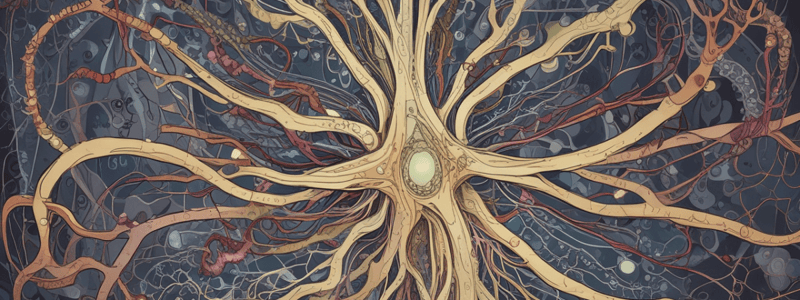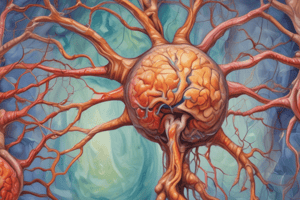Podcast
Questions and Answers
What is the typical structure of the autonomic nervous system?
What is the typical structure of the autonomic nervous system?
- Two-neuron structure (correct)
- Four-neuron structure
- One-neuron structure
- Three-neuron structure
Where is the cell body of the preganglionic neuron located in the sympathetic nervous system?
Where is the cell body of the preganglionic neuron located in the sympathetic nervous system?
- Thoracic and lumbar spinal cord (correct)
- Sacral spinal cord
- Brainstem
- Autonomic ganglion
What is the neurotransmitter released by sympathetic neurons?
What is the neurotransmitter released by sympathetic neurons?
- Norepinephrine (correct)
- Acetylcholine
- Prostaglandins
- Histamine
What is the neurotransmitter released by cholinergic neurons?
What is the neurotransmitter released by cholinergic neurons?
Where are the preganglionic neurons of the parasympathetic nervous system located?
Where are the preganglionic neurons of the parasympathetic nervous system located?
Which part of the spinal cord has the most spinal nerves?
Which part of the spinal cord has the most spinal nerves?
What is the primary mechanism by which beta-adrenergic blocking agents reduce cardiac output?
What is the primary mechanism by which beta-adrenergic blocking agents reduce cardiac output?
Which of the following is a 2nd generation beta blocker?
Which of the following is a 2nd generation beta blocker?
What is the effect of beta-adrenergic blocking agents on the SA node and ectopic pacemakers?
What is the effect of beta-adrenergic blocking agents on the SA node and ectopic pacemakers?
Which of the following is a clinical use of beta-adrenergic blocking agents?
Which of the following is a clinical use of beta-adrenergic blocking agents?
What is the effect of beta-adrenergic blocking agents on the refractory period of the AV node?
What is the effect of beta-adrenergic blocking agents on the refractory period of the AV node?
What is the mechanism by which beta-adrenergic blocking agents reduce renin secretion?
What is the mechanism by which beta-adrenergic blocking agents reduce renin secretion?
Which of the following beta blockers is a hybrid, having both alpha and beta blocking properties?
Which of the following beta blockers is a hybrid, having both alpha and beta blocking properties?
Which receptor subtype is responsible for the vasoconstriction effect of norepinephrine?
Which receptor subtype is responsible for the vasoconstriction effect of norepinephrine?
What is the primary mechanism of action of indirect-acting adrenergic agonists?
What is the primary mechanism of action of indirect-acting adrenergic agonists?
What is the effect of dopamine on the renal vascular bed?
What is the effect of dopamine on the renal vascular bed?
What is the primary use of fenoldopam?
What is the primary use of fenoldopam?
What is the mechanisms of action of guanethidine?
What is the mechanisms of action of guanethidine?
Which of the following is a mixed alpha and beta receptor agonist?
Which of the following is a mixed alpha and beta receptor agonist?
What is the primary therapeutic use of dobutamine?
What is the primary therapeutic use of dobutamine?
What is the effect of alpha 2 receptors on dilator muscle?
What is the effect of alpha 2 receptors on dilator muscle?
Where is endogenous epinephrine produced?
Where is endogenous epinephrine produced?
What is the effect of epinephrine on uveal scleral outflow?
What is the effect of epinephrine on uveal scleral outflow?
What is the use of 1% epinephrine in the treatment of POAG?
What is the use of 1% epinephrine in the treatment of POAG?
What is the diagnosis where epinephrine is used?
What is the diagnosis where epinephrine is used?
What is the side effect of epinephrine in aphakic patients?
What is the side effect of epinephrine in aphakic patients?
What is the characteristic of phenylephrine?
What is the characteristic of phenylephrine?
What is the duration of action of 2.5% and 10% phenylephrine?
What is the duration of action of 2.5% and 10% phenylephrine?
What is the primary mode of action of Brimonidine tartrate in reducing intraocular pressure?
What is the primary mode of action of Brimonidine tartrate in reducing intraocular pressure?
What is the main advantage of Betaxolol over other beta blockers in glaucoma treatment?
What is the main advantage of Betaxolol over other beta blockers in glaucoma treatment?
What is the primary action of Dapiprazole on the eye?
What is the primary action of Dapiprazole on the eye?
Why is Cocaine not commonly used in ophthalmic practice?
Why is Cocaine not commonly used in ophthalmic practice?
What is the primary mechanism of action of Aproclonidine in reducing intraocular pressure?
What is the primary mechanism of action of Aproclonidine in reducing intraocular pressure?
What is the primary indication for Combigan?
What is the primary indication for Combigan?
What is the main side effect of Lumify that is unique to this medication?
What is the main side effect of Lumify that is unique to this medication?
Why is Carteolol considered a safer option for some patients?
Why is Carteolol considered a safer option for some patients?
Flashcards are hidden until you start studying
Study Notes
Regulation of Biological Process
- Hormones: regulate various physiological processes
- Neurotransmitters: transmit signals between neurons
- Histamine: involved in allergic responses
- Prostaglandins: involved in inflammation and smooth muscle contraction
Organization of the Nervous System
- Afferent (sensory) neurons -> PNS -> Efferent (motor) neurons -> Autonomic Nervous System (ANS) or Somatic Nervous System
- Thoracic region has the most spinal nerves
- ANS: regulates involuntary actions (e.g., heart rate, digestion)
- Subdivisions: Sympathetic, Parasympathetic, and Enteric systems
Autonomic Nervous System (ANS)
- Sympathetic system:
- Preganglionic neuron in thoracic and lumbar spinal cord
- Produces widespread physiological activity
- Uses norepinephrine as neurotransmitter
- Parasympathetic system:
- Preganglionic neuron in brainstem and sacral spinal cord
- Produces response on an organ basis
- Uses acetylcholine as neurotransmitter
Neurotransmission
- 3 stages: Preganglionic synapse, Postganglionic synapse, Metabolites excreted in urine
Classification of Beta-Adrenergic Blocking Agents
- Non-selective (1st gen)
- Cardioselective (beta-1 selective, 2nd gen)
- Hybrid antihypertensive drugs (3rd gen)
Clinical Uses of Beta-Blockers
- Hypertension
- Angina pectoris
- Glaucoma
- Migraine
- Thyrotoxicosis
- Arrhythmia prophylaxis
Adrenergic Agonists
- Direct action: drug directly activates receptor
- Indirect action: drug enhances release of norepinephrine
- Mixed action: drug acts both directly and indirectly
- Examples:
- Tyramine (indirect action)
- Cocaine (indirect action)
- Amphetamines (indirect action)
- Pseudoephedrine (direct action)
- Ephedrine (direct action)
Adrenergic Antagonists
- Decrease sympathetic tone of blood vessels
- Results in decrease in total peripheral resistance (TPR)
- Examples:
- Phenoxybenzamine (non-competitive antagonist)
- Phentolamine (competitive reversible antagonist)
Alpha Adrenergic Receptors
- Alpha 1:
- Works through phospholipase C pathway
- Increases intracellular Ca++ in smooth muscle cells
- Contraction of smooth muscle
- Alpha 2:
- Works through adenylate cyclase pathway
- Decreases release of neurotransmitters and hormones
Beta Adrenergic Receptors
- Beta 1:
- Works through stimulation of adenylate cyclase pathway
- Increases cardiac muscle contraction
- Beta 2:
- Works through stimulation of adenylate cyclase pathway
- Relaxation of smooth muscle
- Beta 3:
- Works through stimulation of adenylate cyclase pathway
- Lipolysis in adipose tissue
Studying That Suits You
Use AI to generate personalized quizzes and flashcards to suit your learning preferences.




